Rita Dahbi's Thesis: Gastronomy, Culinary Art, and Future Trends
VerifiedAdded on 2022/01/17
|76
|17739
|145
Thesis and Dissertation
AI Summary
This thesis, submitted to MODUL University Vienna, examines the cultural development of gastronomy, comparing culinary art with future trends. Authored by Rita Dahbi, the research explores the evolution of gastronomy considering the impact of culture and globalization, with a focus on the Viennese gastronomic scene. The study delves into the history of culinary art, analyzes future trends, unique concepts, and gains insights from interviews with experts in the field. The thesis defines key terms, explores the historical context, and investigates the impact of globalization and new media technologies on the industry, highlighting the importance of understanding the market to create awareness. The research includes a detailed methodology, evaluation of findings, and reflection on the current and future state of gastronomy, providing a comprehensive overview of the industry's development and challenges.

The cultural development of gastronomy
Culinary art versus future trends
Submitted to
MODUL University Vienna
Promoted by
Eva Aileen Jungwirth- Edelmann, MA‐
Written by
Rita Dahbi
1211056
Vienna, May 2015
Culinary art versus future trends
Submitted to
MODUL University Vienna
Promoted by
Eva Aileen Jungwirth- Edelmann, MA‐
Written by
Rita Dahbi
1211056
Vienna, May 2015
Paraphrase This Document
Need a fresh take? Get an instant paraphrase of this document with our AI Paraphraser
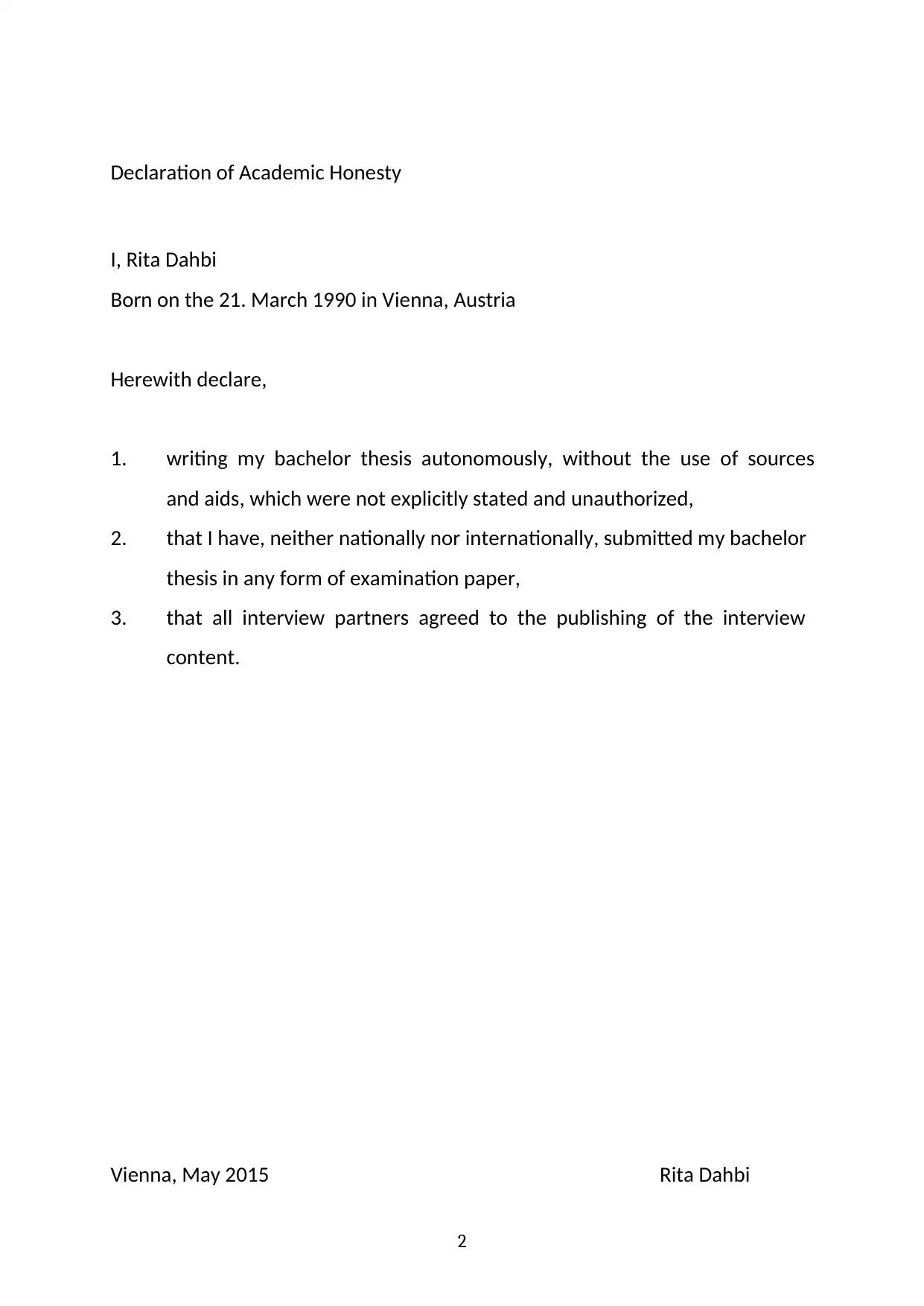
2
Declaration of Academic Honesty
I, Rita Dahbi
Born on the 21. March 1990 in Vienna, Austria
Herewith declare,
1. writing my bachelor thesis autonomously, without the use of sources
and aids, which were not explicitly stated and unauthorized,
2. that I have, neither nationally nor internationally, submitted my bachelor
thesis in any form of examination paper,
3. that all interview partners agreed to the publishing of the interview
content.
Vienna, May 2015 Rita Dahbi
Declaration of Academic Honesty
I, Rita Dahbi
Born on the 21. March 1990 in Vienna, Austria
Herewith declare,
1. writing my bachelor thesis autonomously, without the use of sources
and aids, which were not explicitly stated and unauthorized,
2. that I have, neither nationally nor internationally, submitted my bachelor
thesis in any form of examination paper,
3. that all interview partners agreed to the publishing of the interview
content.
Vienna, May 2015 Rita Dahbi

3
Abstract
Topic: The cultural development of gastronomy culinary art versus future trends
Name Author: Rita Dahbi
Course/ Year: BBA in Tourism and Hospitality Management
Pages: 77
Content: The purpose of the thesis is to understand how gastronomy developed
during years, taking into consideration several aspects such as culture and
globalization, which both, had great impact on the industry.
The paper will focus on the gastronomic scene in Vienna with comparisons to
other cities worldwide.
Moreover, this study analyses future trends as well as unique concepts in all forms
and shades.
Furthermore, the research is conducted in such way to gain a deep insight from
the point of view of different experts of the Viennese culinary scene.
The first part of the thesis lays in defining specific words in order to understand
the whole concept of gastronomy. In the second part of the research, we are
looking deeper in the history of culinary art as well as on future trends and
innovation. Last but not least, the third part of this thesis aims to get answers
from experts working in this field.
Supervisor/ Promoter: Eva Aileen Jungwirth- Edelmann, MA‐
Abstract
Topic: The cultural development of gastronomy culinary art versus future trends
Name Author: Rita Dahbi
Course/ Year: BBA in Tourism and Hospitality Management
Pages: 77
Content: The purpose of the thesis is to understand how gastronomy developed
during years, taking into consideration several aspects such as culture and
globalization, which both, had great impact on the industry.
The paper will focus on the gastronomic scene in Vienna with comparisons to
other cities worldwide.
Moreover, this study analyses future trends as well as unique concepts in all forms
and shades.
Furthermore, the research is conducted in such way to gain a deep insight from
the point of view of different experts of the Viennese culinary scene.
The first part of the thesis lays in defining specific words in order to understand
the whole concept of gastronomy. In the second part of the research, we are
looking deeper in the history of culinary art as well as on future trends and
innovation. Last but not least, the third part of this thesis aims to get answers
from experts working in this field.
Supervisor/ Promoter: Eva Aileen Jungwirth- Edelmann, MA‐
⊘ This is a preview!⊘
Do you want full access?
Subscribe today to unlock all pages.

Trusted by 1+ million students worldwide
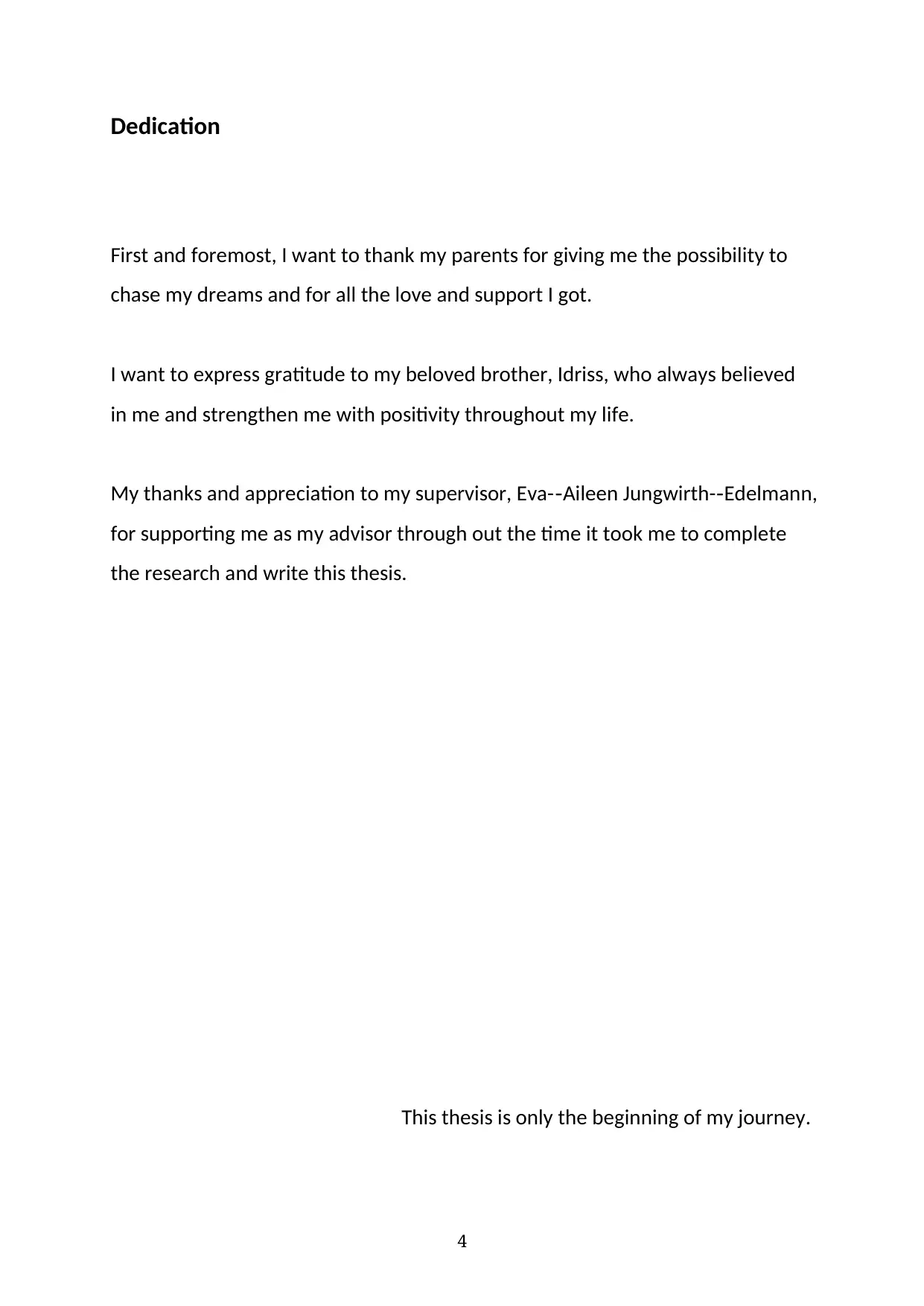
4
Dedication
First and foremost, I want to thank my parents for giving me the possibility to
chase my dreams and for all the love and support I got.
I want to express gratitude to my beloved brother, Idriss, who always believed
in me and strengthen me with positivity throughout my life.
My thanks and appreciation to my supervisor, Eva- Aileen Jungwirth- Edelmann,‐ ‐
for supporting me as my advisor through out the time it took me to complete
the research and write this thesis.
This thesis is only the beginning of my journey.
Dedication
First and foremost, I want to thank my parents for giving me the possibility to
chase my dreams and for all the love and support I got.
I want to express gratitude to my beloved brother, Idriss, who always believed
in me and strengthen me with positivity throughout my life.
My thanks and appreciation to my supervisor, Eva- Aileen Jungwirth- Edelmann,‐ ‐
for supporting me as my advisor through out the time it took me to complete
the research and write this thesis.
This thesis is only the beginning of my journey.
Paraphrase This Document
Need a fresh take? Get an instant paraphrase of this document with our AI Paraphraser
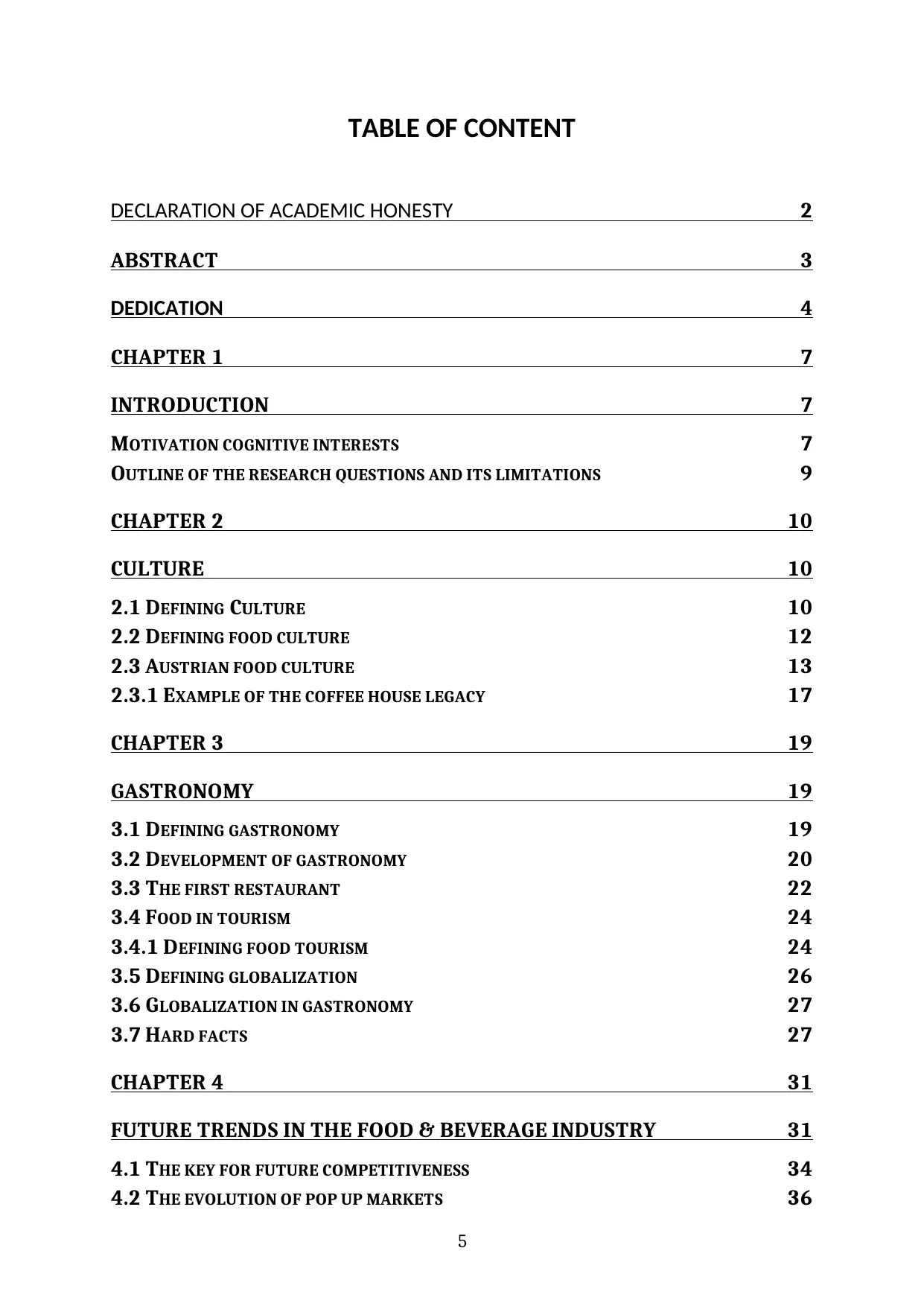
5
TABLE OF CONTENT
DECLARATION OF ACADEMIC HONESTY 2
ABSTRACT 3
DEDICATION 4
CHAPTER 1 7
INTRODUCTION 7
MOTIVATION COGNITIVE INTERESTS 7
OUTLINE OF THE RESEARCH QUESTIONS AND ITS LIMITATIONS 9
CHAPTER 2 10
CULTURE 10
2.1 DEFINING CULTURE 10
2.2 DEFINING FOOD CULTURE 12
2.3 AUSTRIAN FOOD CULTURE 13
2.3.1 EXAMPLE OF THE COFFEE HOUSE LEGACY 17
CHAPTER 3 19
GASTRONOMY 19
3.1 DEFINING GASTRONOMY 19
3.2 DEVELOPMENT OF GASTRONOMY 20
3.3 THE FIRST RESTAURANT 22
3.4 FOOD IN TOURISM 24
3.4.1 DEFINING FOOD TOURISM 24
3.5 DEFINING GLOBALIZATION 26
3.6 GLOBALIZATION IN GASTRONOMY 27
3.7 HARD FACTS 27
CHAPTER 4 31
FUTURE TRENDS IN THE FOOD & BEVERAGE INDUSTRY 31
4.1 THE KEY FOR FUTURE COMPETITIVENESS 34
4.2 THE EVOLUTION OF POP UP MARKETS 36
TABLE OF CONTENT
DECLARATION OF ACADEMIC HONESTY 2
ABSTRACT 3
DEDICATION 4
CHAPTER 1 7
INTRODUCTION 7
MOTIVATION COGNITIVE INTERESTS 7
OUTLINE OF THE RESEARCH QUESTIONS AND ITS LIMITATIONS 9
CHAPTER 2 10
CULTURE 10
2.1 DEFINING CULTURE 10
2.2 DEFINING FOOD CULTURE 12
2.3 AUSTRIAN FOOD CULTURE 13
2.3.1 EXAMPLE OF THE COFFEE HOUSE LEGACY 17
CHAPTER 3 19
GASTRONOMY 19
3.1 DEFINING GASTRONOMY 19
3.2 DEVELOPMENT OF GASTRONOMY 20
3.3 THE FIRST RESTAURANT 22
3.4 FOOD IN TOURISM 24
3.4.1 DEFINING FOOD TOURISM 24
3.5 DEFINING GLOBALIZATION 26
3.6 GLOBALIZATION IN GASTRONOMY 27
3.7 HARD FACTS 27
CHAPTER 4 31
FUTURE TRENDS IN THE FOOD & BEVERAGE INDUSTRY 31
4.1 THE KEY FOR FUTURE COMPETITIVENESS 34
4.2 THE EVOLUTION OF POP UP MARKETS 36
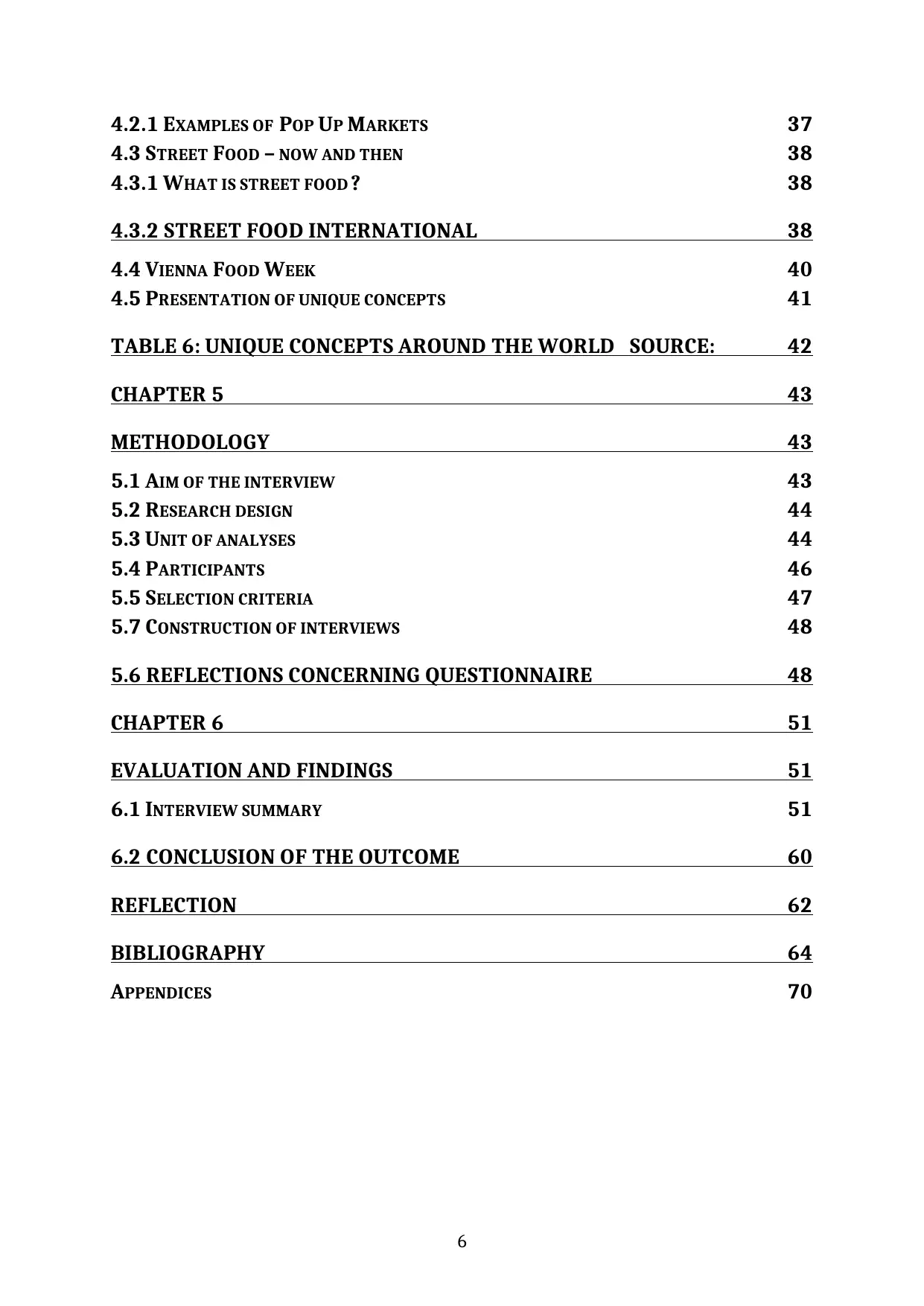
6
4.2.1 EXAMPLES OF POP UP MARKETS 37
4.3 STREET FOOD – NOW AND THEN 38
4.3.1 WHAT IS STREET FOOD ? 38
4.3.2 STREET FOOD INTERNATIONAL 38
4.4 VIENNA FOOD WEEK 40
4.5 PRESENTATION OF UNIQUE CONCEPTS 41
TABLE 6: UNIQUE CONCEPTS AROUND THE WORLD SOURCE: 42
CHAPTER 5 43
METHODOLOGY 43
5.1 AIM OF THE INTERVIEW 43
5.2 RESEARCH DESIGN 44
5.3 UNIT OF ANALYSES 44
5.4 PARTICIPANTS 46
5.5 SELECTION CRITERIA 47
5.7 CONSTRUCTION OF INTERVIEWS 48
5.6 REFLECTIONS CONCERNING QUESTIONNAIRE 48
CHAPTER 6 51
EVALUATION AND FINDINGS 51
6.1 INTERVIEW SUMMARY 51
6.2 CONCLUSION OF THE OUTCOME 60
REFLECTION 62
BIBLIOGRAPHY 64
APPENDICES 70
4.2.1 EXAMPLES OF POP UP MARKETS 37
4.3 STREET FOOD – NOW AND THEN 38
4.3.1 WHAT IS STREET FOOD ? 38
4.3.2 STREET FOOD INTERNATIONAL 38
4.4 VIENNA FOOD WEEK 40
4.5 PRESENTATION OF UNIQUE CONCEPTS 41
TABLE 6: UNIQUE CONCEPTS AROUND THE WORLD SOURCE: 42
CHAPTER 5 43
METHODOLOGY 43
5.1 AIM OF THE INTERVIEW 43
5.2 RESEARCH DESIGN 44
5.3 UNIT OF ANALYSES 44
5.4 PARTICIPANTS 46
5.5 SELECTION CRITERIA 47
5.7 CONSTRUCTION OF INTERVIEWS 48
5.6 REFLECTIONS CONCERNING QUESTIONNAIRE 48
CHAPTER 6 51
EVALUATION AND FINDINGS 51
6.1 INTERVIEW SUMMARY 51
6.2 CONCLUSION OF THE OUTCOME 60
REFLECTION 62
BIBLIOGRAPHY 64
APPENDICES 70
⊘ This is a preview!⊘
Do you want full access?
Subscribe today to unlock all pages.

Trusted by 1+ million students worldwide
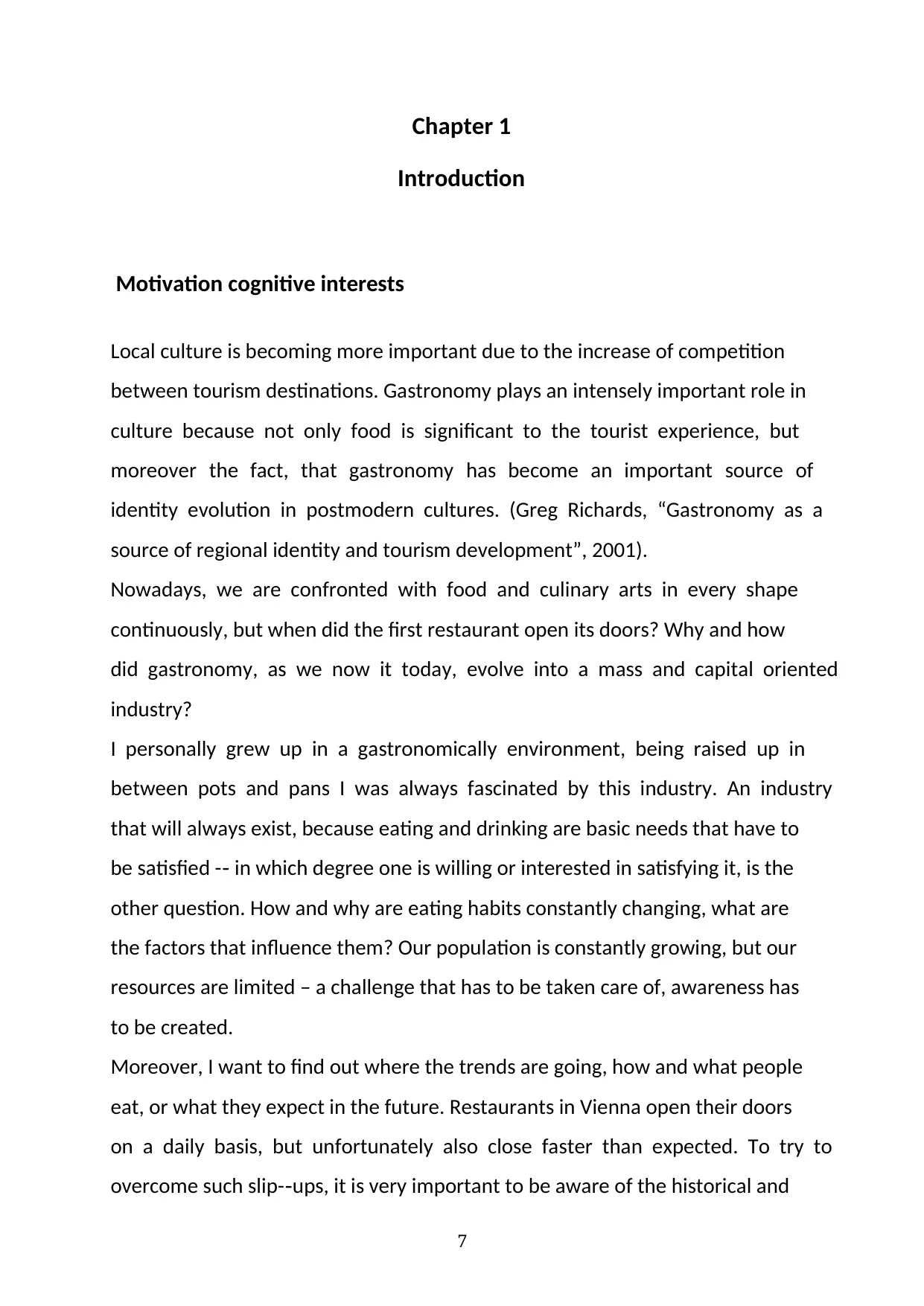
7
Chapter 1
Introduction
Motivation cognitive interests
Local culture is becoming more important due to the increase of competition
between tourism destinations. Gastronomy plays an intensely important role in
culture because not only food is significant to the tourist experience, but
moreover the fact, that gastronomy has become an important source of
identity evolution in postmodern cultures. (Greg Richards, “Gastronomy as a
source of regional identity and tourism development”, 2001).
Nowadays, we are confronted with food and culinary arts in every shape
continuously, but when did the first restaurant open its doors? Why and how
did gastronomy, as we now it today, evolve into a mass and capital oriented
industry?
I personally grew up in a gastronomically environment, being raised up in
between pots and pans I was always fascinated by this industry. An industry
that will always exist, because eating and drinking are basic needs that have to
be satisfied - in which degree one is willing or interested in satisfying it, is the‐
other question. How and why are eating habits constantly changing, what are
the factors that influence them? Our population is constantly growing, but our
resources are limited – a challenge that has to be taken care of, awareness has
to be created.
Moreover, I want to find out where the trends are going, how and what people
eat, or what they expect in the future. Restaurants in Vienna open their doors
on a daily basis, but unfortunately also close faster than expected. To try to
overcome such slip- ups, it is very important to be aware of the historical and‐
Chapter 1
Introduction
Motivation cognitive interests
Local culture is becoming more important due to the increase of competition
between tourism destinations. Gastronomy plays an intensely important role in
culture because not only food is significant to the tourist experience, but
moreover the fact, that gastronomy has become an important source of
identity evolution in postmodern cultures. (Greg Richards, “Gastronomy as a
source of regional identity and tourism development”, 2001).
Nowadays, we are confronted with food and culinary arts in every shape
continuously, but when did the first restaurant open its doors? Why and how
did gastronomy, as we now it today, evolve into a mass and capital oriented
industry?
I personally grew up in a gastronomically environment, being raised up in
between pots and pans I was always fascinated by this industry. An industry
that will always exist, because eating and drinking are basic needs that have to
be satisfied - in which degree one is willing or interested in satisfying it, is the‐
other question. How and why are eating habits constantly changing, what are
the factors that influence them? Our population is constantly growing, but our
resources are limited – a challenge that has to be taken care of, awareness has
to be created.
Moreover, I want to find out where the trends are going, how and what people
eat, or what they expect in the future. Restaurants in Vienna open their doors
on a daily basis, but unfortunately also close faster than expected. To try to
overcome such slip- ups, it is very important to be aware of the historical and‐
Paraphrase This Document
Need a fresh take? Get an instant paraphrase of this document with our AI Paraphraser
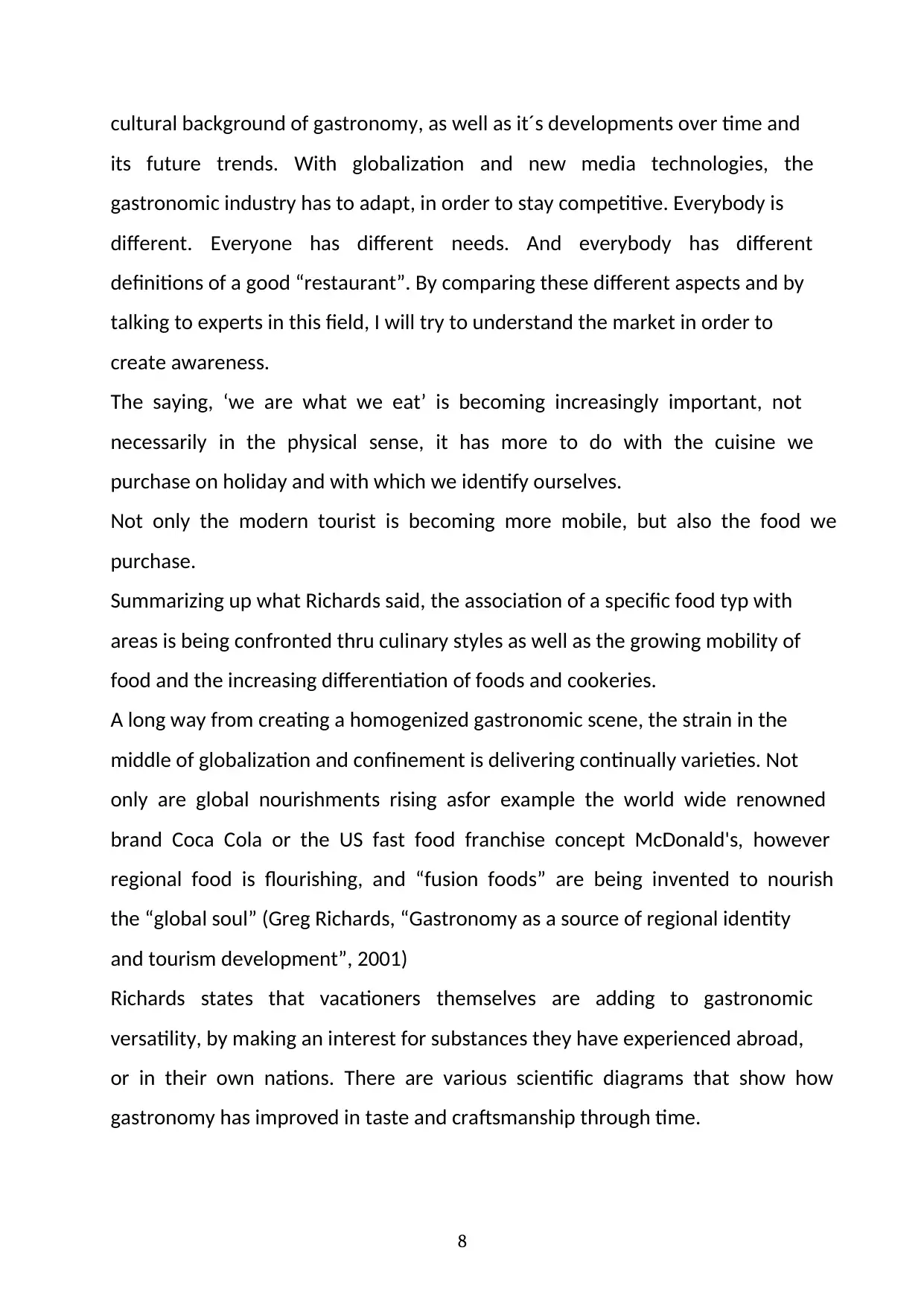
8
cultural background of gastronomy, as well as it´s developments over time and
its future trends. With globalization and new media technologies, the
gastronomic industry has to adapt, in order to stay competitive. Everybody is
different. Everyone has different needs. And everybody has different
definitions of a good “restaurant”. By comparing these different aspects and by
talking to experts in this field, I will try to understand the market in order to
create awareness.
The saying, ‘we are what we eat’ is becoming increasingly important, not
necessarily in the physical sense, it has more to do with the cuisine we
purchase on holiday and with which we identify ourselves.
Not only the modern tourist is becoming more mobile, but also the food we
purchase.
Summarizing up what Richards said, the association of a specific food typ with
areas is being confronted thru culinary styles as well as the growing mobility of
food and the increasing differentiation of foods and cookeries.
A long way from creating a homogenized gastronomic scene, the strain in the
middle of globalization and confinement is delivering continually varieties. Not
only are global nourishments rising asfor example the world wide renowned
brand Coca Cola or the US fast food franchise concept McDonald's, however
regional food is flourishing, and “fusion foods” are being invented to nourish
the “global soul” (Greg Richards, “Gastronomy as a source of regional identity
and tourism development”, 2001)
Richards states that vacationers themselves are adding to gastronomic
versatility, by making an interest for substances they have experienced abroad,
or in their own nations. There are various scientific diagrams that show how
gastronomy has improved in taste and craftsmanship through time.
cultural background of gastronomy, as well as it´s developments over time and
its future trends. With globalization and new media technologies, the
gastronomic industry has to adapt, in order to stay competitive. Everybody is
different. Everyone has different needs. And everybody has different
definitions of a good “restaurant”. By comparing these different aspects and by
talking to experts in this field, I will try to understand the market in order to
create awareness.
The saying, ‘we are what we eat’ is becoming increasingly important, not
necessarily in the physical sense, it has more to do with the cuisine we
purchase on holiday and with which we identify ourselves.
Not only the modern tourist is becoming more mobile, but also the food we
purchase.
Summarizing up what Richards said, the association of a specific food typ with
areas is being confronted thru culinary styles as well as the growing mobility of
food and the increasing differentiation of foods and cookeries.
A long way from creating a homogenized gastronomic scene, the strain in the
middle of globalization and confinement is delivering continually varieties. Not
only are global nourishments rising asfor example the world wide renowned
brand Coca Cola or the US fast food franchise concept McDonald's, however
regional food is flourishing, and “fusion foods” are being invented to nourish
the “global soul” (Greg Richards, “Gastronomy as a source of regional identity
and tourism development”, 2001)
Richards states that vacationers themselves are adding to gastronomic
versatility, by making an interest for substances they have experienced abroad,
or in their own nations. There are various scientific diagrams that show how
gastronomy has improved in taste and craftsmanship through time.

9
Outline of the research questions and its limitations
The aim of this thesis is to outline the history of gastronomy, its developments
and definitions. Moreover, I would like to outline the changes; globalisation
and emancipation have brought to this sector.
Furthermore, this thesis aims at showing what impact our culturally diverse
society has on the ever- changing culinary art. Outlining how future trends‐
affect, what and how we eat today.
Due to a limited timeframe, my thesis will primarily focus on the gastronomic
scene in Vienna, with occasional examples from other major cities worldwide.
The research will be conducted in such a way as to give a summary on existing
literature and in- depth interviews with pioneers in the field working, in Vienna.‐
The research aims at outlining the current situation of gastronomy in Vienna
and identifying how trends give shape to food consumption.
Outline of the research questions and its limitations
The aim of this thesis is to outline the history of gastronomy, its developments
and definitions. Moreover, I would like to outline the changes; globalisation
and emancipation have brought to this sector.
Furthermore, this thesis aims at showing what impact our culturally diverse
society has on the ever- changing culinary art. Outlining how future trends‐
affect, what and how we eat today.
Due to a limited timeframe, my thesis will primarily focus on the gastronomic
scene in Vienna, with occasional examples from other major cities worldwide.
The research will be conducted in such a way as to give a summary on existing
literature and in- depth interviews with pioneers in the field working, in Vienna.‐
The research aims at outlining the current situation of gastronomy in Vienna
and identifying how trends give shape to food consumption.
⊘ This is a preview!⊘
Do you want full access?
Subscribe today to unlock all pages.

Trusted by 1+ million students worldwide
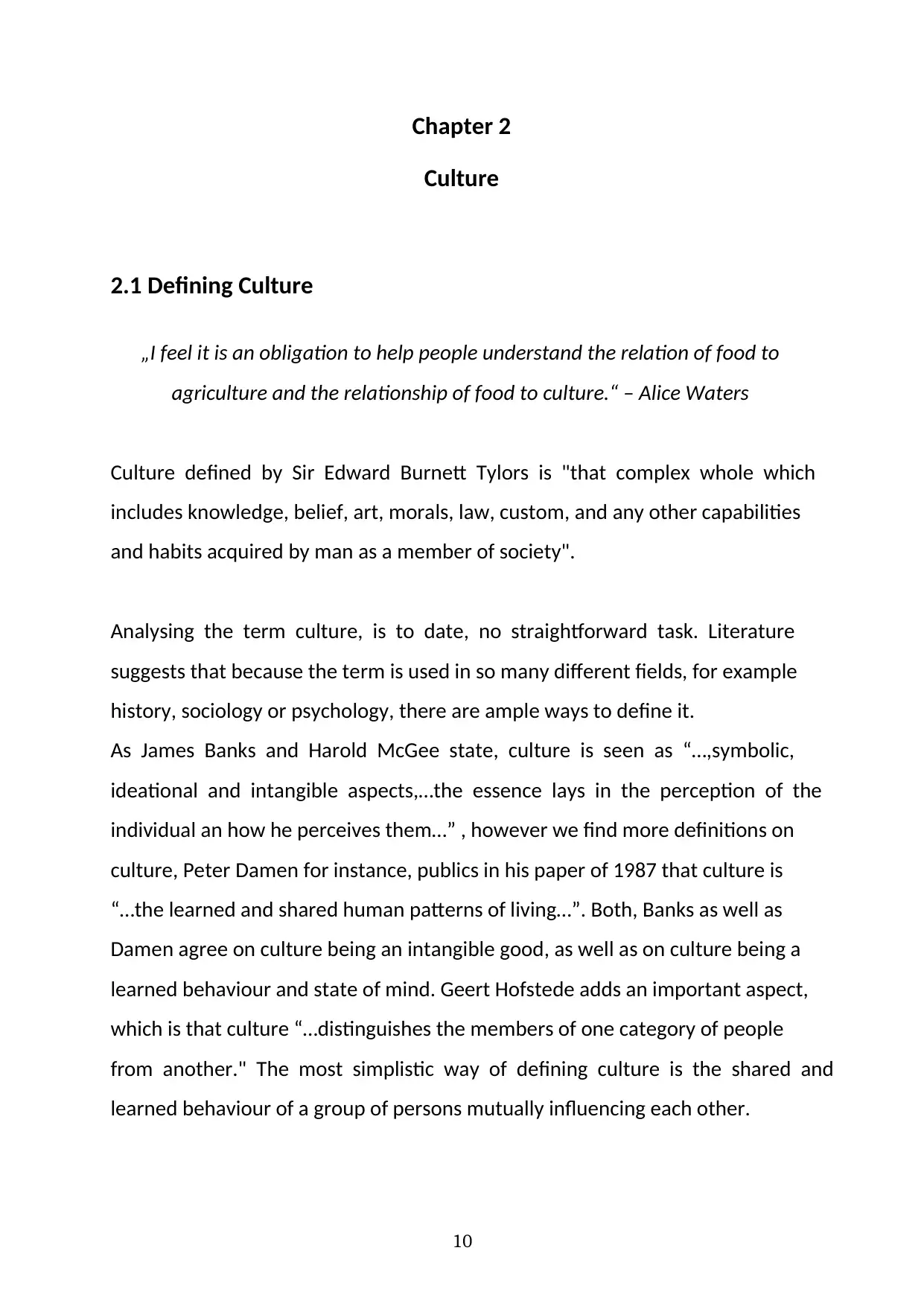
10
Chapter 2
Culture
2.1 Defining Culture
„I feel it is an obligation to help people understand the relation of food to
agriculture and the relationship of food to culture.“ – Alice Waters
Culture defined by Sir Edward Burnett Tylors is "that complex whole which
includes knowledge, belief, art, morals, law, custom, and any other capabilities
and habits acquired by man as a member of society".
Analysing the term culture, is to date, no straightforward task. Literature
suggests that because the term is used in so many different fields, for example
history, sociology or psychology, there are ample ways to define it.
As James Banks and Harold McGee state, culture is seen as “…,symbolic,
ideational and intangible aspects,…the essence lays in the perception of the
individual an how he perceives them…” , however we find more definitions on
culture, Peter Damen for instance, publics in his paper of 1987 that culture is
“…the learned and shared human patterns of living…”. Both, Banks as well as
Damen agree on culture being an intangible good, as well as on culture being a
learned behaviour and state of mind. Geert Hofstede adds an important aspect,
which is that culture “…distinguishes the members of one category of people
from another." The most simplistic way of defining culture is the shared and
learned behaviour of a group of persons mutually influencing each other.
Chapter 2
Culture
2.1 Defining Culture
„I feel it is an obligation to help people understand the relation of food to
agriculture and the relationship of food to culture.“ – Alice Waters
Culture defined by Sir Edward Burnett Tylors is "that complex whole which
includes knowledge, belief, art, morals, law, custom, and any other capabilities
and habits acquired by man as a member of society".
Analysing the term culture, is to date, no straightforward task. Literature
suggests that because the term is used in so many different fields, for example
history, sociology or psychology, there are ample ways to define it.
As James Banks and Harold McGee state, culture is seen as “…,symbolic,
ideational and intangible aspects,…the essence lays in the perception of the
individual an how he perceives them…” , however we find more definitions on
culture, Peter Damen for instance, publics in his paper of 1987 that culture is
“…the learned and shared human patterns of living…”. Both, Banks as well as
Damen agree on culture being an intangible good, as well as on culture being a
learned behaviour and state of mind. Geert Hofstede adds an important aspect,
which is that culture “…distinguishes the members of one category of people
from another." The most simplistic way of defining culture is the shared and
learned behaviour of a group of persons mutually influencing each other.
Paraphrase This Document
Need a fresh take? Get an instant paraphrase of this document with our AI Paraphraser

11
(Useem, J., & Useem, R. (1963). Human Organizations, 22(3). By comparing the
definitions from above, one can easily extract, that the word “behaviour” has
an extensive meaning when one talks about culture. “Value” and “knowledge”
are considered being the foundations of culture, as well as “traditions”.
With the explosion of new communication systems, as well as the birth of the
“urban lifestyle”, one can witness the emergence of several new cultural pools
as you can find in the table below.
Culture Definition Source
High culture Society or culture, in this
sense, alludes to having
what now be known as
"modern" taste in the
expressive arts or
humanities.
Dell Hymes (1969).
“Reinventing
Anthropology”.
Popular culture Popular society is
alluding to what you
listen to, what you read,
what you wear and how
you talk and so forth the
talked words.
R. L. Holloway Jr. (1969).
"Culture: A Human domain"
The art of lifestyle This implies that
whatever remains of
society truly needs to
concentrate on the
universe of
craftsmanship and
culture as a fundamental
hotspot for
arrangements, as well as
methods for discovering
arrangements and an
entire knew idea of what
a profitable life truly
implies.
M. Tomasello (1999). "The
Human Adaptation for
Culture"
(Useem, J., & Useem, R. (1963). Human Organizations, 22(3). By comparing the
definitions from above, one can easily extract, that the word “behaviour” has
an extensive meaning when one talks about culture. “Value” and “knowledge”
are considered being the foundations of culture, as well as “traditions”.
With the explosion of new communication systems, as well as the birth of the
“urban lifestyle”, one can witness the emergence of several new cultural pools
as you can find in the table below.
Culture Definition Source
High culture Society or culture, in this
sense, alludes to having
what now be known as
"modern" taste in the
expressive arts or
humanities.
Dell Hymes (1969).
“Reinventing
Anthropology”.
Popular culture Popular society is
alluding to what you
listen to, what you read,
what you wear and how
you talk and so forth the
talked words.
R. L. Holloway Jr. (1969).
"Culture: A Human domain"
The art of lifestyle This implies that
whatever remains of
society truly needs to
concentrate on the
universe of
craftsmanship and
culture as a fundamental
hotspot for
arrangements, as well as
methods for discovering
arrangements and an
entire knew idea of what
a profitable life truly
implies.
M. Tomasello (1999). "The
Human Adaptation for
Culture"

12
Table 1: More recent definitions of culture
In the more recent definitions of culture, the main purpose is the well being of
the human, as well as the achievement of a balanced working conditions and a
healthy lifestyle. There are most probably many other new emerging
definitions, but the main aspect remains that culture is: the intangible good, a
state of mind, a behaviour that is learned and lived.
2.2 Defining food culture
It is difficult to see why we require a nourishment society, unless we
comprehend what such a society truly is and where it origins from.
Food culture is defined as “…a connection to food in a pure and deep sense…it
is knowing what it takes to bring forth food, rejoicing in times of plenty, and
doing all we can to help one another in times of scarcity…the conversation had
around a table three times a day and it is the health given to our bodies from
the essence of those plants and animals...” (Shannon U. (2013) Nourishing
Days – Plan to Eat.)
Ethipio born Marcus samuellson, has a deep knowledge of society and the stew
of substance. S was adopted and raised by Swedish parents. He says: as he
says, “Everywhere I’ve been, everything I am is reflected in my feelings about
food. America is called a melting pot, but I think it’s more like a stew where
individual flavours are still present yet create a whole. Like me, many of us
Physical culture Combination of
movements designed to
increase strength,
fitness and flexibility.
Geertz, Clifford. 1973. “The
Interpretation of Cultures:
Selected Essays.”
Table 1: More recent definitions of culture
In the more recent definitions of culture, the main purpose is the well being of
the human, as well as the achievement of a balanced working conditions and a
healthy lifestyle. There are most probably many other new emerging
definitions, but the main aspect remains that culture is: the intangible good, a
state of mind, a behaviour that is learned and lived.
2.2 Defining food culture
It is difficult to see why we require a nourishment society, unless we
comprehend what such a society truly is and where it origins from.
Food culture is defined as “…a connection to food in a pure and deep sense…it
is knowing what it takes to bring forth food, rejoicing in times of plenty, and
doing all we can to help one another in times of scarcity…the conversation had
around a table three times a day and it is the health given to our bodies from
the essence of those plants and animals...” (Shannon U. (2013) Nourishing
Days – Plan to Eat.)
Ethipio born Marcus samuellson, has a deep knowledge of society and the stew
of substance. S was adopted and raised by Swedish parents. He says: as he
says, “Everywhere I’ve been, everything I am is reflected in my feelings about
food. America is called a melting pot, but I think it’s more like a stew where
individual flavours are still present yet create a whole. Like me, many of us
Physical culture Combination of
movements designed to
increase strength,
fitness and flexibility.
Geertz, Clifford. 1973. “The
Interpretation of Cultures:
Selected Essays.”
⊘ This is a preview!⊘
Do you want full access?
Subscribe today to unlock all pages.

Trusted by 1+ million students worldwide
1 out of 76
Your All-in-One AI-Powered Toolkit for Academic Success.
+13062052269
info@desklib.com
Available 24*7 on WhatsApp / Email
![[object Object]](/_next/static/media/star-bottom.7253800d.svg)
Unlock your academic potential
Copyright © 2020–2025 A2Z Services. All Rights Reserved. Developed and managed by ZUCOL.